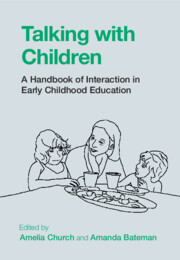Part III - Interaction and Inclusion
Published online by Cambridge University Press: 16 June 2022
Summary

- Type
- Chapter
- Information
- Talking with ChildrenA Handbook of Interaction in Early Childhood Education, pp. 307 - 444Publisher: Cambridge University PressPrint publication year: 2022



